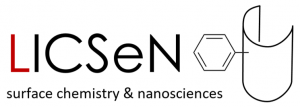In the last 20 years, fullerene-based supramolecular assemblies were extensively investigated. Early works were mainly concerned with the complexation of C60 with molecular building blocks that favor the formation of inclusion complexes. Later, more sophisticated structures, in which the encoding information was introduced onto the fullerene using classical covalent functionalization, were reported. This approach has permitted to increase continuously the size, the order, and the complexity of the supramolecular assemblies and to afford, for example, fullerene-based micelles, vesicles or aggregates, polymers, liquid crystals and also the organization of fullerene on electrode or nanoparticle surfaces. We described the synthesis and the characterization of several fullerene-porphyrin or phthalocyanine dyads by CuAAC. The fullerene derivatives exhibited a rich polymorphism, which was investigated by AFM and SEM.
Molecular self-assembly on surfaces is driven by the range of interactions between the molecules themselves and the substrate. Generally, a face-on structure is favored for aromatic molecules lying flat on the surface. Here we report on the supramolecular self-assembly of 5,10,15,20-tetrakis(10-bromoanthracen-9-yl)porphyrin on the Ag(111) and Ag(110) surfaces. Well-ordered molecular chains were observed by room-temperature scanning tunneling microscopy on both surfaces. The relatively small size of the unit cell revealed an edge-on configuration of the porphyrin macrocycles, i.e. perpendicular to the surface plane, as confirmed by molecular mechanics calculations. Distinct intermolecular interactions were found on the two surfaces, providing different molecular chain orientations on Ag(111) and on Ag(110).

Main contact: Stéphane Campidelli.





